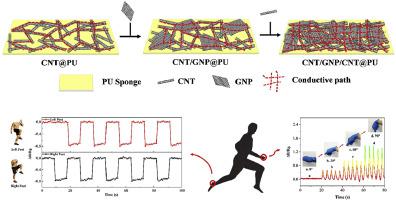当前位置:
X-MOL 学术
›
Compos. Sci. Technol.
›
论文详情
Our official English website, www.x-mol.net, welcomes your feedback! (Note: you will need to create a separate account there.)
Flexible and high-performance piezoresistive strain sensors based on carbon Nanoparticles@Polyurethane sponges
Composites Science and Technology ( IF 9.1 ) Pub Date : 2020-11-01 , DOI: 10.1016/j.compscitech.2020.108437 Xuezhong Zhang , Dong Xiang , Wanqiu Zhu , Yongfeng Zheng , Eileen Harkin-Jones , Ping Wang , Chunxia Zhao , Hui Li , Bin Wang , Yuntao Li
Composites Science and Technology ( IF 9.1 ) Pub Date : 2020-11-01 , DOI: 10.1016/j.compscitech.2020.108437 Xuezhong Zhang , Dong Xiang , Wanqiu Zhu , Yongfeng Zheng , Eileen Harkin-Jones , Ping Wang , Chunxia Zhao , Hui Li , Bin Wang , Yuntao Li

|
Abstract In this work, flexible and high-performance piezoresistive strain sensors were fabricated by simple layer-by-layer electrostatic self-assembly of carbon nanoparticles on commercial polyurethane (PU) sponges. It was shown that the sponge-based strain sensors exhibited obviously positive and negative piezoresistive characteristics under tensile and compressive strains, respectively. The alternate assembly of carbon nanotubes (CNTs) and graphene nanoplatelets (GNPs) contributed to the construction of a more complete conductive network and significantly improved the sensing performance of the sensor due to the synergistic effect between CNTs and GNPs. Compared with the CNT@PU and CNT/GNP@PU sponge strain sensors, the CNT/GNP/CNT@PU sensor had a larger strain detection range and higher linearity. Besides, the CNT/GNP/CNT@PU sponge strain sensor showed high sensitivity (GF = 43,000 at 60% tensile strain and GF = −1.1 at 50% compressive strain), responsive capability to very small strain (0.05%) and outstanding stability during 3000 loading cycles. Due to its excellent sensing performance, the CNT/GNP/CNT@PU sensor enabled monitoring of various physiological activities, including finger movements, wrist bending and walking etc. In addition, a 5 × 5 sensor array based on the sponge-based strain sensor was prepared to achieve accurate identification of weight distribution. This study provides valuable information for the development of flexible strain sensors with high-performance and low-cost.
中文翻译:

基于碳纳米颗粒@聚氨酯海绵的柔性高性能压阻应变传感器
摘要 在这项工作中,通过在商用聚氨酯 (PU) 海绵上简单地逐层静电自组装碳纳米颗粒,制备了灵活且高性能的压阻应变传感器。结果表明,基于海绵的应变传感器在拉伸和压缩应变下分别表现出明显的正压阻特性和负压阻特性。碳纳米管 (CNT) 和石墨烯纳米片 (GNP) 的交替组装有助于构建更完整的导电网络,并且由于 CNT 和 GNP 之间的协同效应,显着提高了传感器的传感性能。与CNT@PU和CNT/GNP@PU海绵应变传感器相比,CNT/GNP/CNT@PU传感器具有更大的应变检测范围和更高的线性度。除了,CNT/GNP/CNT@PU 海绵应变传感器显示出高灵敏度(在 60% 拉伸应变时 GF = 43,000,在 50% 压缩应变时 GF = -1.1)、对非常小的应变 (0.05%) 的响应能力和 3000加载周期。由于其出色的传感性能,CNT/GNP/CNT@PU 传感器能够监测各种生理活动,包括手指运动、手腕弯曲和行走等。此外,基于海绵应变传感器的 5×5 传感器阵列准备实现对重量分布的准确识别。该研究为开发高性能、低成本的柔性应变传感器提供了有价值的信息。05%) 和 3000 次加载循环期间的出色稳定性。由于其出色的传感性能,CNT/GNP/CNT@PU 传感器能够监测各种生理活动,包括手指运动、手腕弯曲和行走等。此外,基于海绵应变传感器的 5×5 传感器阵列准备实现对重量分布的准确识别。该研究为开发高性能、低成本的柔性应变传感器提供了有价值的信息。05%) 和 3000 次加载循环期间的出色稳定性。由于其优异的传感性能,CNT/GNP/CNT@PU 传感器能够监测各种生理活动,包括手指运动、手腕弯曲和行走等。此外,基于海绵应变传感器的 5×5 传感器阵列准备实现对重量分布的准确识别。该研究为开发高性能、低成本的柔性应变传感器提供了有价值的信息。制备了基于海绵应变传感器的 5×5 传感器阵列,以实现重量分布的准确识别。该研究为开发高性能、低成本的柔性应变传感器提供了有价值的信息。制备了基于海绵应变传感器的 5×5 传感器阵列,以实现重量分布的准确识别。该研究为开发高性能、低成本的柔性应变传感器提供了有价值的信息。
更新日期:2020-11-01
中文翻译:

基于碳纳米颗粒@聚氨酯海绵的柔性高性能压阻应变传感器
摘要 在这项工作中,通过在商用聚氨酯 (PU) 海绵上简单地逐层静电自组装碳纳米颗粒,制备了灵活且高性能的压阻应变传感器。结果表明,基于海绵的应变传感器在拉伸和压缩应变下分别表现出明显的正压阻特性和负压阻特性。碳纳米管 (CNT) 和石墨烯纳米片 (GNP) 的交替组装有助于构建更完整的导电网络,并且由于 CNT 和 GNP 之间的协同效应,显着提高了传感器的传感性能。与CNT@PU和CNT/GNP@PU海绵应变传感器相比,CNT/GNP/CNT@PU传感器具有更大的应变检测范围和更高的线性度。除了,CNT/GNP/CNT@PU 海绵应变传感器显示出高灵敏度(在 60% 拉伸应变时 GF = 43,000,在 50% 压缩应变时 GF = -1.1)、对非常小的应变 (0.05%) 的响应能力和 3000加载周期。由于其出色的传感性能,CNT/GNP/CNT@PU 传感器能够监测各种生理活动,包括手指运动、手腕弯曲和行走等。此外,基于海绵应变传感器的 5×5 传感器阵列准备实现对重量分布的准确识别。该研究为开发高性能、低成本的柔性应变传感器提供了有价值的信息。05%) 和 3000 次加载循环期间的出色稳定性。由于其出色的传感性能,CNT/GNP/CNT@PU 传感器能够监测各种生理活动,包括手指运动、手腕弯曲和行走等。此外,基于海绵应变传感器的 5×5 传感器阵列准备实现对重量分布的准确识别。该研究为开发高性能、低成本的柔性应变传感器提供了有价值的信息。05%) 和 3000 次加载循环期间的出色稳定性。由于其优异的传感性能,CNT/GNP/CNT@PU 传感器能够监测各种生理活动,包括手指运动、手腕弯曲和行走等。此外,基于海绵应变传感器的 5×5 传感器阵列准备实现对重量分布的准确识别。该研究为开发高性能、低成本的柔性应变传感器提供了有价值的信息。制备了基于海绵应变传感器的 5×5 传感器阵列,以实现重量分布的准确识别。该研究为开发高性能、低成本的柔性应变传感器提供了有价值的信息。制备了基于海绵应变传感器的 5×5 传感器阵列,以实现重量分布的准确识别。该研究为开发高性能、低成本的柔性应变传感器提供了有价值的信息。



























 京公网安备 11010802027423号
京公网安备 11010802027423号